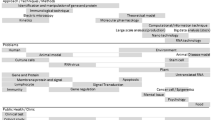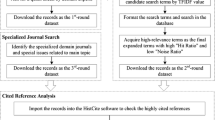Abstract
We report here a simple method to identify the ‘emerging topics’ in life sciences. First, the keywords selected from MeSH terms on PubMed by filtering the terms based on their increment rate of the appearance, and, then, were sorted into groups dealing with the same topics by ‘co-word’ analysis. These topics were defined as ‘emerging topics’. The survey of the emerging keywords with high increment rates of appearance between 1972 to 2006 showed that emerging topics changed dramatically year by year, and that the major shift of the topics occurred in the late 90s; the topics that cover technical and conceptual aspects in molecular biology to the more systematic ‘-omics’-related and nanoscience-related aspects. We further investigated trends in emerging topics within various sub-fields in the life sciences.







Similar content being viewed by others
References
Batageji, V., & Mrvar, A. (2002). Pajek—analysis and visualization of large networks. Lecture Notes in Computer Science, 2265, 477–478.
Braam, R. R., Moed, H. F., & van Raan, A. F. J. (1991). Mapping of science by combined co-citation and word analysis. I. Structural aspects. Journal of the American Society for Information Science, 42(4), 233–251.
Callon, M., Courtial, J. P., Turner, W. A., & Bauin, S. (1983). From translations to problematic networks—an introduction to co-word analysis. Social Science Information Sur Les Sciences Sociales, 22, 191–235.
Callon, M., Law, J., & Rip, A. (1986). Mapping the dynamics of science and technology-sociology of science in the real world. London: The MacMillian Press.
Chen, C. (2006). CiteSpace II: Detecting and visualizing emerging trends and transient patterns in scientific literature. Journal of the American Society for Information Science and Technology, 57(3), 359–377.
Ding, Y., Chowdhury, G. G., & Foo, S. (2001). Bibliometric cartography of information retrieval research by using co-word analysis. Information Processing and Management, 37, 817–842.
Fujigaki, Y. (1998). Filling the gap between discussions on science and scientists’ everyday activities: Applying the autopoiesis system theory to scientific knowledge. Social Science Information, 37(1), 5–22.
Lee, W. H. (2008). How to identify emerging research fields using scientometrics: An example in the field of Information Security. Scientometrics, 76, 503–525.
Leydesdorff, L. (1995). The challenge of scientometrics. Leiden, The Netherlands: DSWO Press, Leiden University.
Noyons, E., Moed, H., & van Raan, A. F. J. (1999). Integrating research performance analysis and science mapping. Scientometrics, 46(3), 591–604.
Ohniwa, R. L., Denawa, M., Kudo, M., Nakamura, K., & Takeyasu, K. (2004). Perspective factor a novel indicator for the assessment of journal quality. Research Evaluation, 13, 175–180.
Ohniwa, R. L., Hibino, A., & Takeyasu, K. (2007). Perspective factor; past, present and future of life sciences. Proceedings of international society for scientometrics and informatics 2007, II, pp. 908–909.
Price, D. J. D. (1963). Little science, big science. New York: Columbia University Press.
Schulman, J. (2000). Using medical subject headings (MeSH) to examine patterns in American medicine-preliminary consideration of vocabulary change as a metric. http://www.nlm.nih.gov/mesh/patterns.html.
Small, H. (2006). Tracking and predicting growth areas in science. Scientometrics, 68(3), 595–610.
Tseng, Y. H., Lin, Y. I., Lee, Y. Y., Hung, W. C., & Lee, C. H. (2009). A comparison of methods for detecting hot topics. Scientometrics, 81(1), 73–90.
Upham, S. P., & Small, H. (2010). Emerging research fronts in science and technology: patterns of new knowledge development. Scientometrics, 83, 15–38.
Author information
Authors and Affiliations
Corresponding author
Electronic supplementary material
Below is the link to the electronic supplementary material.
Rights and permissions
About this article
Cite this article
Ohniwa, R.L., Hibino, A. & Takeyasu, K. Trends in research foci in life science fields over the last 30 years monitored by emerging topics. Scientometrics 85, 111–127 (2010). https://doi.org/10.1007/s11192-010-0252-2
Received:
Published:
Issue Date:
DOI: https://doi.org/10.1007/s11192-010-0252-2




